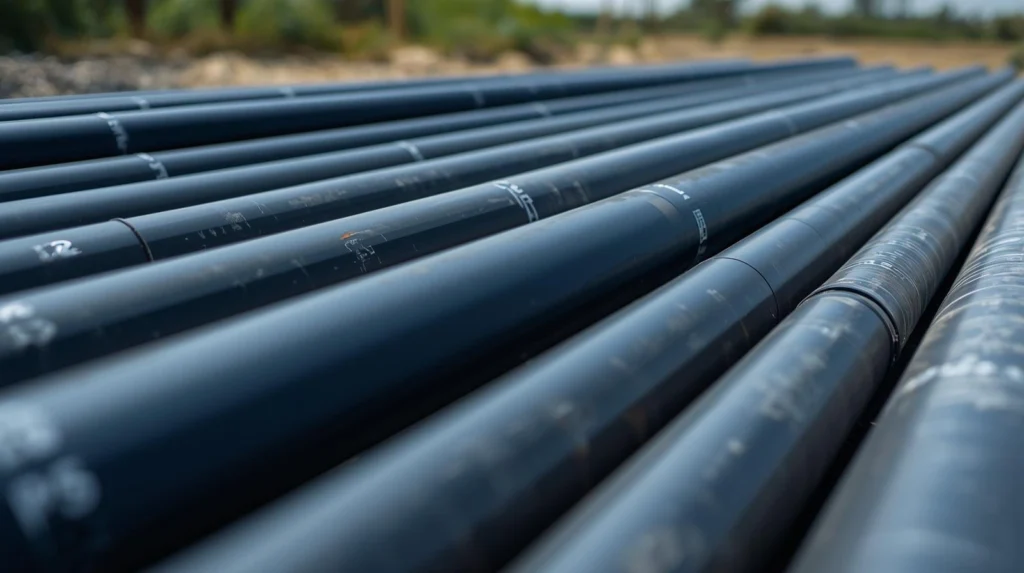Have you ever wondered how rural areas can achieve reliable and sustainable water systems with limited resources?
Water supply systems in rural areas often face significant challenges—aging infrastructure, limited access to clean water, and high maintenance costs. The solution lies in the use of HDPE (High-Density Polyethylene) pipes. These pipes offer a modern solution for upgrading water systems, ensuring long-lasting and cost-effective infrastructure.
In this blog, we’ll explore the numerous benefits of choosing HDPE pipes for rural water supply systems. You’ll learn why HDPE pipes are the best option for improving water accessibility and quality in rural areas, providing both short-term and long-term solutions. From durability to ease of installation, HDPE pipes have revolutionized the way rural communities access water, making them an indispensable part of modern infrastructure.
Why Are HDPE Pipes Ideal for Rural Water Supply Systems?
1. What Makes HDPE Pipes Durable and Long-Lasting?
When it comes to rural water supply systems, durability is key. HDPE pipes are known for their superior strength and resistance to wear and tear. Made from high-density polyethylene, these pipes can withstand extreme weather conditions, pressure fluctuations, and chemical exposure, making them perfect for rural environments.
The long lifespan of HDPE pipes—often exceeding 50 years—ensures that your water system will require minimal maintenance and replacement. The robust nature of HDPE pipes makes them resistant to corrosion, a common issue faced by traditional metal pipes, which leads to frequent maintenance and early replacements.
Pro Tip: Installing HDPE pipes reduces the risk of costly and frequent repairs, ensuring your rural water supply system remains functional for decades.
2. How Do HDPE Pipes Contribute to Cost Savings?
One of the biggest challenges for rural areas is working within limited budgets. HDPE pipes provide an affordable solution for upgrading water supply systems without breaking the bank.
HDPE pipes are lightweight, making them easy to handle, transport, and install, which significantly reduces labor costs. Additionally, the long lifespan of HDPE pipes means that communities won’t have to deal with constant repairs, saving even more money in the long run. The low maintenance cost of HDPE pipes also contributes to overall cost savings.
Real-World Example: In rural areas of India, the implementation of HDPE pipes in water supply systems led to a 30% reduction in overall water infrastructure maintenance costs over a 10-year period.
3. What Are the Environmental Benefits of HDPE Pipes?
In the context of sustainability, HDPE pipes are an eco-friendly solution. These pipes are 100% recyclable, reducing environmental impact when they reach the end of their life cycle. Unlike metal or PVC pipes, which may leach harmful substances into the surrounding soil or water, HDPE pipes are non-toxic, ensuring that rural communities are not exposed to dangerous chemicals.
Furthermore, the installation of HDPE pipes in water supply systems reduces water loss. The smooth internal surface of HDPE pipes minimizes friction and leakage, ensuring that more water reaches the intended destination, which is crucial in water-scarce areas.
Pro Tip: By choosing HDPE pipes, rural communities contribute to environmental conservation by reducing water waste and minimizing the carbon footprint of their water infrastructure.
4. How Easy Are HDPE Pipes to Install in Rural Areas?
In rural areas where access to skilled labor and modern tools may be limited, HDPE pipes offer a solution. Their lightweight design and flexibility make installation much easier compared to traditional piping materials like steel or concrete. The use of fusion welding technology ensures a strong, leak-proof joint, even in challenging environments.
Additionally, the installation of HDPE pipes requires less specialized equipment and training, reducing the time and cost associated with setting up new water systems. The speed of installation is particularly important in rural areas where access to clean water is a pressing concern.
Expert Insight: HDPE pipes can be installed using minimal resources, reducing the logistical challenges associated with water supply projects in remote regions.
5. How Do HDPE Pipes Handle Pressure and Temperature Fluctuations?
Rural areas often face challenges such as fluctuating water pressures and extreme weather conditions. HDPE pipes are specifically designed to handle both low and high water pressures without compromising structural integrity. Additionally, HDPE pipes remain flexible and resilient even in freezing or extremely hot conditions.
Their ability to expand and contract without cracking makes them an excellent choice for areas that experience significant temperature changes. HDPE pipes are less likely to break under pressure or extreme conditions, ensuring a reliable water supply year-round.
Real-World Example: In the cold regions of Canada, HDPE pipes have been used to create robust water supply systems that operate efficiently even during the harsh winter months, where other piping materials might fail.
6. What Are the Advantages of HDPE Pipes Over Other Materials?
Traditional piping materials, such as cast iron, steel, and PVC, often fall short in rural water supply systems due to issues like corrosion, brittleness, and leakage. In comparison, HDPE pipes offer a range of advantages:
- Corrosion Resistance: Unlike metal pipes, HDPE pipes do not rust or corrode, ensuring longer service life.
- Leak-Free: HDPE pipes can be heat-fused to create leak-proof joints, preventing water loss and contamination.
- Lightweight: Easier handling and transportation compared to heavier traditional materials.
When compared to alternatives, HDPE pipes provide a more reliable, durable, and cost-effective solution for rural water supply systems.
High-Quality Pipes & Fittings – Built to Last
Conclusion
HDPE pipes offer an unparalleled combination of durability, cost-effectiveness, and environmental sustainability, making them the ideal choice for rural water supply systems. Whether you are upgrading an existing system or starting a new project, HDPE pipes ensure long-lasting, reliable, and eco-friendly water infrastructure.
By choosing HDPE pipes, rural communities can address key challenges—such as budget constraints, water loss, and environmental impact—while ensuring access to clean, safe water for years to come. Take the first step toward a sustainable and efficient water supply system by considering HDPE pipes for your next rural infrastructure project.
FAQ Section
1. What is the lifespan of HDPE pipes in rural water supply systems?
HDPE pipes typically have a lifespan of 50 years or more, making them a long-term solution for rural water supply systems.
2. How do HDPE pipes reduce water wastage?
HDPE pipes have a smooth inner surface that minimizes friction and leakage, ensuring more water reaches the destination.
3. Are HDPE pipes environmentally friendly?
Yes, HDPE pipes are 100% recyclable and do not leach harmful chemicals into the environment, making them an eco-friendly option.
4. How easy is it to install HDPE pipes in rural areas?
HDPE pipes are lightweight, flexible, and easy to install, even in remote areas with limited resources and skilled labor.
5. Can HDPE pipes handle extreme weather conditions?
Yes, HDPE pipes are resistant to extreme temperatures and pressure fluctuations, making them suitable for a variety of climates.
6. How do HDPE pipes compare to PVC or steel pipes?
HDPE pipes offer superior durability, corrosion resistance, and leak-free connections compared to PVC and steel pipes, making them a better choice for rural water systems.
7. Are HDPE pipes cost-effective for rural water projects?
Yes, the low installation and maintenance costs of HDPE pipes make them a cost-effective choice for rural water supply systems, especially in the long term.


